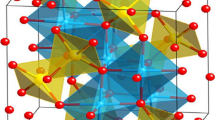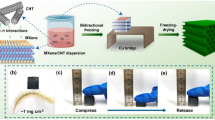Abstract
The present study has revealed that C40H38B2Cl2N4O6, a boron-containing compound, exhibits exceptional electrochemical performance when utilized as an electrode in supercapacitor applications. The specific capacitance values of C40H38B2Cl2N4O6 were found to be significantly higher than that of the traditional electrode material, C15H14BNO2·HCl, in both KOH and Na2SO4 electrolyte solutions. In particular, when tested in KOH, the specific capacitance value of C40H38B2Cl2N4O6 was a staggering 3.74 times greater than that of C15H14BNO2·HCl, demonstrating its exceptional energy storage capabilities. The superior performance of C40H38B2Cl2N4O6 can be attributed to its unique porous structure and high surface area, which enhances its ability to store charge. This research serves as a significant step towards the development of more advanced energy storage devices, and paves the way for C40H38B2Cl2N4O6 to be employed as a promising material in future supercapacitor applications.









Similar content being viewed by others
Data availability
Not applicable.
References
A. Razzaq et al., Asymmetric inter-linkages between green technology innovation and consumption-based carbon emissions in BRICS countries using quantile-on-quantile framework. Technol. Soc 66, 101656 (2021)
M. Abdel-Nasser, K. Mahmoud, Accurate photovoltaic power forecasting models using deep LSTM-RNN. Neural Comput. Appl 31(7), 2727–2740 (2019)
L. Xue et al., Renewable energy use and ecological footprints mitigation: evidence from selected south asian economies. Sustainability 13(4), 1613 (2021)
M. Yang et al., Will the Public pay for Green Products? Based on Analysis of the Influencing Factors for Chinese’s Public Willingness to pay a Price Premium for Green Products. Environmental Science and Pollution Research, 2021. 28(43): pp. 61408–61422
S. Zhang et al., A method to fabricate uniform silver nanowires transparent electrode using Meyer rod coating and dynamic heating. J. Mater. Sci.: Mater. Electron 30(20), 18702–18709 (2019)
P. Veerakumar et al., Research progress on porous carbon supported metal/metal oxide nanomaterials for supercapacitor electrode applications. Ind. Eng. Chem. Res 59(14), 6347–6374 (2020)
J. Yang et al., Graphene foam as a Stable Anode Material in lithium-ion Batteries (International Journal of Energy Research, 2021)
S. Özarslan et al., A double-functional carbon material as a supercapacitor electrode and hydrogen production: Cu-doped tea factory waste catalyst. J. Mater. Sci.: Mater. Electron 32(24), 28909–28918 (2021)
G.K. Khiam et al., Modelling and optimization for methylene blue adsorption using graphene oxide/chitosan composites via artificial neural network-particle swarm optimization. Mater. Today Chem. 24, 100946 (2022)
J.Y. Lim et al., Recent trends in the synthesis of graphene and graphene oxide based nanomaterials for removal of heavy metals—A review. J. Ind. Eng. Chem 66, 29–44 (2018)
J.Y. Lim et al., Novel fabrication of functionalized graphene oxide via magnetite and 1-butyl-3-methylimidazolium tetrafluoroborate. Nano-Struct. Nano-Obj. 16, 403–411 (2018)
D. Majumdar, S. Ghosh, Recent advancements of copper oxide based nanomaterials for supercapacitor applications. J. Energy Storage 34, 101995 (2021)
S. Özarslan et al., Production of dual functional carbon material from biomass treated with NaOH for supercapacitor and catalyst. Energy Storage 3(5), e257 (2021)
Q. Xu et al., Synthesis of gold nanoparticle-loaded magnetic carbon microsphere based on reductive and binding properties of polydopamine for recyclable catalytic applications. New J. Chem 44(37), 16227–16233 (2020)
Y. Shi et al., Nanostructured conductive polymers for advanced energy storage. Chem. Soc. Rev 44(19), 6684–6696 (2015)
P.E. Lokhande, U.S. Chavan, A. Pandey, Materials and fabrication methods for electrochemical supercapacitors: overview. Electrochem. Energy Reviews 3(1), 155–186 (2020)
P. Simon, Y. Gogotsi, Perspectives for electrochemical capacitors and related devices. Nat. Mater 19(11), 1151–1163 (2020)
M. Biswal et al., Magnetism in BiFe1 – xNixO3: studied through electron spin resonance spectroscopy. J. Mater. Sci.: Mater. Electron 29(24), 20595–20602 (2018)
M. Akdemir, D.E. Karakaş, M. Kaya, Synthesis of a dual-functionalized carbon‐based material as catalyst and supercapacitor for efficient hydrogen production and energy storage: Pd‐supported pomegranate peel. Energy Storage 4(1), e284 (2022)
S. Özarslan et al., A novel tea factory waste metal-free catalyst as promising supercapacitor electrode for hydrogen production and energy storage: a dual functional material. Fuel 305, 121578 (2021)
C. Zhan et al., Boron supercapacitors. ACS Energy Letters 1(6), 1241–1246 (2016)
B.C. Das et al., Boron chemicals in diagnosis and therapeutics. Future Med. Chem. 5(6), 653–676 (2013)
A. Kilic, E. Aytar, L. Beyazsakal, A Novel dopamine-based Boronate Esters with the Organic Base as highly efficient, stable, and Green Catalysts for the Conversion of CO2 with Epoxides to cyclic carbonates. Energy Technol. 9(9), 2100478 (2021)
A. Kilic et al., Catechol-type ligand containing new modular design dioxaborinane compounds: use in the transfer hydrogenation of various ketones. Catal Commun 111, 42–46 (2018)
A. Kilic et al., Synthesis and effective catalytic performance in cycloaddition reactions with CO 2 of boronate esters versus N-heterocyclic carbene (NHC)-stabilized boronate esters. Sustainable Energy & Fuels 4(11), 5682–5696 (2020)
K.L. Tu, L.D. Nghiem, A.R. Chivas, Boron removal by reverse osmosis membranes in seawater desalination applications. Sep. Purif. Technol 75(2), 87–101 (2010)
L. Vondung et al., Phosphine-stabilized Borylenes and Boryl Anions as Ligands? Redox Reactivity in Boron‐Based Pincer Complexes. Angew. Chem. Int. Ed 55(46), 14450–14454 (2016)
A. Chardon, J. Rouden, J. Blanchet, Borinic acid mediated hydrosilylations: reductions of carbonyl derivatives. Eur. J. Org. Chem 2019(5), 995–998 (2019)
D. Franz, S. Inoue, Cationic complexes of boron and aluminum: an early 21st century viewpoint. Chemistry–A Eur. J. 25(12), 2898–2926 (2019)
A. Kilic et al., The chiral boronate-catalyzed asymmetric transfer hydrogenation of various aromatic ketones to high-value alcohols: Preparation and spectroscopic studies. J. Organomet. Chem 890, 1–12 (2019)
Y. Ma et al., Boron-catalyzed aromatic C–H bond silylation with hydrosilanes. J. Am. Chem. Soc 138(11), 3663–3666 (2016)
S. Nehate et al., A review of boron carbon nitride thin films and progress in nanomaterials. Mater. Today Adv. 8, 100106 (2020)
L. Manjakkal et al., Flexible self-charging supercapacitor based on graphene-Ag-3D graphene foam electrodes. Nano Energy 51, 604–612 (2018)
C. Zequine et al., High per formance and flexible supercapacitors based on carbonized bamboo fibers for wide temperature applications. Sci. Rep 6(1), 1–10 (2016)
S. Ghosh et al., Supercapacitive vertical graphene nanosheets in aqueous electrolytes Nano-struct. Nano-obj. 10, 42–50 (2017)
Q. Cheng et al., Graphene and nanostructured MnO2 composite electrodes for supercapacitors. Carbon 49(9), 2917–2925 (2011)
X. Yan, Y. Yu, X. Yang, Effects of electrolytes on the capacitive behavior of nitrogen/phosphorus co-doped nonporous carbon nanofibers: an insight into the role of phosphorus groups. RSC Adv 4(48), 24986–24990 (2014)
J. Gamby et al., Studies and characterisations of various activated carbons used for carbon/carbon supercapacitors. J. Power Sources 101(1), 109–116 (2001)
X. Zhu et al., Sustainable activated carbons from dead ginkgo leaves for supercapacitor electrode active materials. Chem. Eng. Sci. 181, 36–45 (2018)
X. Zhang et al., Effect of aqueous electrolytes on the electrochemical behaviors of supercapacitors based on hierarchically porous carbons. J. Power Sources 216, 290–296 (2012)
I.I.G. Inal, M. Akdemir, M. Kaya, Microcystis aeruginosa supported-Mn catalyst as a new promising supercapacitor electrode: a dual functional material. Int. J. Hydrog. Energy 46, 21534–21541 (2021)
I. Karbhal et al., Laser patterning of boron carbon nitride electrodes for flexible micro-supercapacitor with remarkable electrochemical stability/capacity. Carbon 171, 750–757 (2021)
H. Guo, Q. Gao, Boron and nitrogen co-doped porous carbon and its enhanced properties as supercapacitor. J. Power Sources 186(2), 551–556 (2009)
J. Zhang et al., Preparation of boron-doped diamond foam film for supercapacitor applications. Appl. Surf. Sci 506, 144645 (2020)
V. Thirumal et al., Synthesis and characterization of boron doped graphene nanosheets for supercapacitor applications. Synth. Met 220, 524–532 (2016)
M. Khandelwal et al., Nitrogen and boron co-doped densified laser-induced graphene for supercapacitor applications. Chem. Eng. J 428, 131119 (2022)
Funding
The authors have not disclosed any funding.
Author information
Authors and Affiliations
Contributions
AK: conceptualization, investigation, and visualization. RS: supervision and review. MA: conceptualization, investigation, and visualization. HDK: supervision and review. MK: conceptualization, investigation, visualization, writing—review and editing. SH: review and editing
Corresponding author
Ethics declarations
Conflict of interest
The authors declare that they have no competing interests.
Ethical approval
The authors declare that they have no conflict of interest.
Consent to participate
Not applicable.
Consent to publish
Not applicable.
Additional information
Publisher’s Note
Springer Nature remains neutral with regard to jurisdictional claims in published maps and institutional affiliations.
Rights and permissions
Springer Nature or its licensor (e.g. a society or other partner) holds exclusive rights to this article under a publishing agreement with the author(s) or other rightsholder(s); author self-archiving of the accepted manuscript version of this article is solely governed by the terms of such publishing agreement and applicable law.
About this article
Cite this article
Kilic, A., Soylemez, R., Akdemİr, M. et al. A study on supercapacitor electrode material from trigonal planar and (N→B) dative bond stabilized tetrahedral boron-containing compounds. J Mater Sci: Mater Electron 34, 609 (2023). https://doi.org/10.1007/s10854-023-09979-3
Received:
Accepted:
Published:
DOI: https://doi.org/10.1007/s10854-023-09979-3




